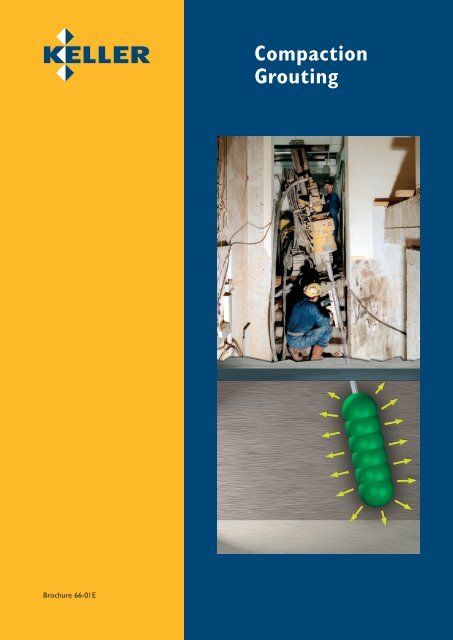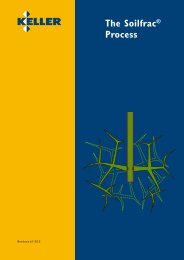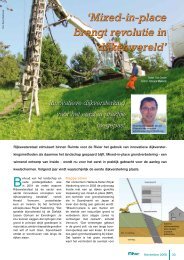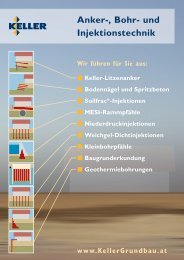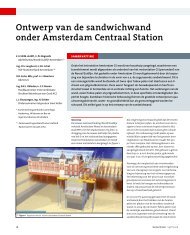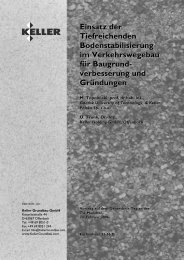The Compaction Grouting Process : Process description - Smet-Keller
The Compaction Grouting Process : Process description - Smet-Keller
The Compaction Grouting Process : Process description - Smet-Keller
You also want an ePaper? Increase the reach of your titles
YUMPU automatically turns print PDFs into web optimized ePapers that Google loves.
Brochure 66-01E<br />
<strong>Compaction</strong><br />
<strong>Grouting</strong>
Contents<br />
<strong>The</strong> method on the market ...... 3<br />
<strong>Process</strong> <strong>description</strong> ..................... 4<br />
Soil improvement ........................ 6<br />
Foundation rehabilitation........... 8<br />
Cavity grouting ........................... 10<br />
2
Development<br />
<strong>The</strong> compaction grouting process, which was first applied in the USA during the 1950ies and further<br />
developed, mainly by engineers of Hayward Baker Inc., is gaining more and more acceptance in Europe<br />
since the beginning of the 1990ies.<br />
When <strong>Keller</strong> first applied this technique in Europe, we were able to build upon the rich experience<br />
gained by our American sister company and since then have been continuously developing this process.<br />
Fields of application / Position on the market<br />
While compaction grouting had originally been used only for the foundation rehabilitation of settlement<br />
sensitive structures, the field of application in the meantime has been extended. Nowadays this technique<br />
is used in various fields of application – which frequently can be combined in a single project.<br />
• Soil improvement<br />
Improvement of soils with insufficient bearing capacity, respectively with an increase in relative density,<br />
e.g. as an alternative or supplement to pile foundations or stone columns.<br />
• Stabilisation and rehabilitation of foundations<br />
Increase or restoration of the bearing capacity of the soil under an existing foundation, e.g. in cases of<br />
increase in load or settlement damages. This process is an alternative to Soilcrete ® or mini piles and/<br />
or serves as pre-treatment when applying the Soilcrete ® and Soilfrac ® process.<br />
• Cavity <strong>Grouting</strong><br />
Force locking backfill of very porous soils, erosions or cavities, e.g. in backfilled areas which have not<br />
sufficiently been compacted, in karst, in case of damages caused by water pipes or below carriageway<br />
slabs.<br />
This process constitutes a multi-purpose supplement to existing specialised ground engineering<br />
techniques and, in addition, can be combined with almost all known procedures.<br />
COMPACTION GROUTING TODAY<br />
3
<strong>The</strong> <strong>Compaction</strong> <strong>Grouting</strong> <strong>Process</strong><br />
When applying the compaction grouting process usually a stiff to plastic grout is injected<br />
into the soil under pressure. It expands in the soil as a relatively homogeneous mass and<br />
at the same time is forming almost ball-shaped grout bulbs. <strong>The</strong> soil surrounding the<br />
grouted area is displaced and at the same time compacted. Compared to other grouting<br />
techniques, the grout material neither penetrates into the pores of the in-situ soil (as is<br />
the case with the classical injection) nor are local cracks formed (as is the case with the<br />
Soilfrac ® technique).<br />
During the compaction grouting process pressure and grout quantity as well as possible<br />
deformations at ground surface, respectively at structures are monitored. Depending on<br />
the design requirements, the compaction grouting process will be terminated either<br />
when reaching a maximum pressure, a maximum grout volume, when achieving the<br />
desired uplift of the structure or in case of grout material flowing out on the site surface.<br />
<strong>The</strong> execution method of the compaction grouting process is laid down in the European<br />
Standard EN 12 715.<br />
Range of Application<br />
<strong>The</strong> compaction grouting method may be used for the improvement of non-cohesive<br />
soils, especially in cases, where soils of loose to medium density are encountered.<br />
This method is also used in fine-grained soils *) in order to install elements of higher<br />
strength and bearing capacity in soils of low bearing capacity, thus improving the load<br />
bearing behaviour of the soil.<br />
When using this technique in saturated clayey soil, a temporary increase of the pore<br />
water pressure can be observed.<br />
* Due to the fact that fine-grained soils cannot be compacted from the soil mechanics’ point of view –<br />
by applying the same technique – strictly speaking, consolidation grouting is carried out.<br />
TECHNIQUE<br />
Range of Application for <strong>Grouting</strong> Techniques<br />
Techniques<br />
Soilcrete ® /Jet <strong>Grouting</strong><br />
Soilfrac ® /Compensation <strong>Grouting</strong><br />
<strong>Compaction</strong> <strong>Grouting</strong><br />
Ultra fine cements<br />
Water-glass solution (low viscosity)<br />
Cement suspensions<br />
Clay Silt Sand Gravel Boulder<br />
100<br />
80<br />
60<br />
40<br />
20<br />
Sieve pass [weight %]<br />
Economical<br />
Uneconomical<br />
0,002 0,006 0,02 0,06 0,2 0,6 2,0 6,0 20 60<br />
Grain size [mmØ]<br />
0<br />
1 Installation in a basement<br />
2 Installation next to an<br />
existing building<br />
3 Installation on a<br />
construction site<br />
1 2 3<br />
4
▲<br />
1 2 3<br />
Grout<br />
location<br />
Measurement<br />
and quality<br />
control devices<br />
Dry pre-mixed grout<br />
Mixer and<br />
pump<br />
1 Installation of the Grout Pipe<br />
<strong>The</strong> grout pipe is either installed<br />
by means of a drill rig or a vibro<br />
hammer, depending on the soil and<br />
on the treatment requirements.<br />
2 <strong>Compaction</strong> <strong>Grouting</strong><br />
<strong>The</strong> grout paste is prepared in the mixing<br />
plant and pressed into the soil by means of<br />
a custom-built grout pump.<br />
While gradually pulling or penetrating the<br />
grout pipes, individual intersecting grout<br />
bulbs are consecutively formed, thus creating<br />
column shaped structural elements.<br />
3 Staged <strong>Compaction</strong><br />
In order to achieve a uniform<br />
compaction of the soil, the<br />
injections are at first executed in<br />
a large primary grid, and may be<br />
compacted further by means of a<br />
secondary grid.<br />
Quality Assurance<br />
Evaluation<br />
Program: <strong>Compaction</strong> grouting (1.0.2)<br />
Inventory: 130569 Site:<br />
Lot: 0 Point: 52 1K1 Ref. No.: 1<br />
Date: 23.07.02 Time: 20:48:03 Interval: 2 sec<br />
Legend:<br />
Dept.: Consulting<br />
and Development<br />
n10<br />
0 10 20 30 40<br />
Time<br />
[sec]<br />
Depth<br />
[m]<br />
Grout pressure<br />
[bar]<br />
Grout volume<br />
[l/step]<br />
1<br />
0<br />
0 5 10 15 20 0 10 20 30 40 0 200 400 600<br />
2<br />
1000<br />
3<br />
Quality as well as suitability of the fresh<br />
grout is constantly assured by measuring<br />
its slump.<br />
2000<br />
4<br />
5<br />
3000<br />
6<br />
<strong>The</strong> degree of compaction can be<br />
controlled by the following parameters,<br />
depending on the requirements:<br />
• evaluation of the automatically<br />
recorded process parameters by<br />
means of a <strong>Keller</strong> in-house software<br />
• deformation measurements at<br />
site surface or structures<br />
• soundings (CPT, SPT) before and<br />
after the compaction grouting<br />
process<br />
4000<br />
Point duration: 19,06 min Max. depth: 14,50 m<br />
M4-print out: depth, pressure and grout volume<br />
are continuously recorded and shown on a time<br />
axis. Alternatively, recordings can be drawn on a<br />
depth axis.<br />
depth [m]<br />
7<br />
8<br />
9<br />
10<br />
11<br />
12<br />
grouted section<br />
13<br />
Diagram of a penetrometer test<br />
(pre/post)<br />
pre<br />
post<br />
5
Ground Improvement<br />
Frequently, soil improvement is necessary to increase the bearing capacity of poor<br />
soils, in case of a structure which has been proposed to be founded on this soil.<br />
In addition to the deep vibro techniques (such as vibro compaction and vibro<br />
replacement) which have been applied by <strong>Keller</strong> for decades, the compaction<br />
grouting technique has proven to be a suitable alternative in many cases.<br />
For the execution of compaction grouting works a number of different drill rigs<br />
and and vibro hammers can be used. <strong>The</strong> execution method can therefore be<br />
easily adapted to the prevailing local conditions.<br />
In principle, the compaction grouting technique can achieve a similar degree of<br />
improvement as by the deep vibro techniques.<br />
<strong>The</strong> compaction grouting method is particularly well suited as an alternative or<br />
supplement to deep vibro techniques in the following cases:<br />
• confined working space<br />
• limited working height<br />
• vibration-free technique required (e.g. because of a highly sensitive structure<br />
in the vicinity)<br />
• compaction at very large depths<br />
• for intermittant strong soil layers, which cannot be penetrated by a depth<br />
vibrator, thus making its use inefficient.<br />
1<br />
COMPACTING<br />
4<br />
Visualisation<br />
Each working level is shown separately<br />
A Working level / grid<br />
B Pressure distribution<br />
C Quantity distribution<br />
D Injections<br />
2 3<br />
A<br />
B<br />
1 Exposed section of a<br />
compaction grout column<br />
2 Exposed compaction area<br />
3 Soil improvement for the<br />
construction of a new<br />
power plant in Indonesia<br />
4 Modern software is used<br />
for simulation and<br />
visualisation<br />
C<br />
D<br />
6
Foundation Rehabilitation<br />
Subsoil and footing together form the foundation system. Detrimental external<br />
influences and long-term processes which affect the subsoil conditions, are known<br />
to lead occasionally to a reduction in the bearing capacity of a foundation.<br />
Structural modifications of existing buildings often require an increase of the<br />
bearing capacity of the foundation.<br />
In all these cases, the compaction grouting process can be sensibly applied for<br />
target-oriented rehabilitation of existing footings, in order to stop incompatible<br />
settlements and deformations and to reverse them, if necessary, or to increase<br />
the bearing capacity of an existing foundation in a controlled manner.<br />
<strong>The</strong> compaction grouting process also has proven to be an excellent technique<br />
for underpinnings, in case of sensitive or non-homogeneous soil conditions are<br />
encountered or if the causes of the settlements could not exhaustively be<br />
determined.<br />
REHABILITATION<br />
1 1<br />
3<br />
1 Rehabilitation of a road<br />
bridge after flood damage<br />
2 Rehabilitation of the footings<br />
under a residential building<br />
3 Improvement of the stability<br />
of a church<br />
4 Rehabilitation of a footing<br />
underneath a historical<br />
building<br />
2<br />
bearing strata<br />
low-strength soil<br />
8
4<br />
9
Cavity <strong>Grouting</strong><br />
With ressources becoming more and more scarce and prices for land increasing,<br />
it becomes increasingly necessary to build structures in areas, which were<br />
previously considered to be unsuitable for construction due to their poor soil<br />
properties.<br />
In former mining regions, mining tailing backfills were for example sold as cheap<br />
construction lots after a certain rest period and are frequently used for the<br />
construction of industrial and commercial buildings.<br />
Due to the direct interaction between soil and grout material the compaction<br />
grouting process is a particularly suitable technique to avoid or compensate nasty<br />
surprises as a result of unforeseen non-homogeneities or cavities occurring during<br />
the construction phase when building on poor soils of this kind.<br />
GROUTING<br />
Before treatment<br />
1 1<br />
1 Soil improvement under<br />
the slab of a multi-storey<br />
warehouse under<br />
construction<br />
2 Improvement principle:<br />
compaction underneath<br />
a settled slab<br />
After treatment<br />
Significant compaction and<br />
increase in stiffness of the<br />
mining tailings achieving<br />
the desired uniformity of<br />
strength, partial reversal<br />
of settlements<br />
Soil Improvement<br />
2<br />
Staged compaction<br />
from bottom to top<br />
Primary and intermediate<br />
injections in a uniform grid<br />
Slab<br />
settlement<br />
0,0 m<br />
Compacted<br />
gravel bed<br />
3,5 m<br />
Mining tailings<br />
Non-homogeneous,<br />
loose to very loose,<br />
timber and iron<br />
obstacles<br />
14,5 m<br />
Natural, cohesive<br />
soil deposit<br />
10
1<br />
11
www.<strong>Keller</strong>Grundbau.com<br />
www.<strong>Keller</strong>Holding.com<br />
www.kellerfareast.com<br />
www.<strong>Keller</strong>Grundbau.ae<br />
A company of <strong>Keller</strong> Group plc


